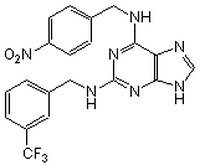406170 Sigma-AldrichIP6K Inhibitor - CAS 519178-28-0 - Calbiochem
The IP6K Inhibitor, also referenced under CAS 519178-28-0, controls the biological activity of IP6K.
More>> The IP6K Inhibitor, also referenced under CAS 519178-28-0, controls the biological activity of IP6K. Less<<Sinônimos: N²-(m-Trifluorobenzyl), N⁶-(p-nitrobenzyl)purine, Inositol-1,4,5-trisphosphate 3-Kinase Inhibitor, IP3K Inhibitor, Kcs1 Inhibitor, TNP
Produtos recomendados
Panorama geral
| Replacement Information |
|---|
Tabela com principais espec.
| CAS # | Empirical Formula |
|---|---|
| 519178-28-0 | C₂₀H₁₆F₃N₇O₂ |
Preço e Disponibilidade
| Número de catálogo | Disponibilidade | Embalagem | Qtde/Emb. | Preço | Quantidade | |
|---|---|---|---|---|---|---|
| 406170-5MG |
|
Ampola plástica | 5 mg |
|
— |
| Description | |
|---|---|
| Overview | A cell-permeable 2,6-disubstituted purine compound that, although originally identified as a reversible, ATP-competitive inhibitor against the conversion of Ins(1,4,5)P3 (Cat. Nos. 407123 & 407137) to Ins(1,3,4,5)P4 (Cat. No. 407126) by IP3K (IC50 = 18 µM; [ATP] = 10 μM), acts in fact as a much more effective inhibitor against the IP6K1/2/3-catalyzed conversion of InsP6 (Cat. No. 407125) to 5-[PP]- InsP6 or InsP7 (IC50 = 0.47 μM against IP6K1; [ATP] = 1 mM) due to a much higher affinity of ATP toward IP3K than IP6K (Km of ATP for the respective enzymes = 0.01 vs 1000 μM). Shown to potently inhibit cellular InsP7 level (IC50 = 0.55 μM in HeLa cultures), while being less potent in increasing the cellular InsP3 accumulation (>10 µM in HeLa cultures). TNP is also effective against S. cerevisiae IP6K, Kcs1, but not Vip/PPIP5Ks, enzymes that catalyze the pyrophosphorylation at the 1/3 position of InsP6 and InsP7, in either human or yeast species or two other IP3 metabolizing enzymes, PLC and IP3 5-ppase. |
| Catalogue Number | 406170 |
| Brand Family | Calbiochem® |
| Synonyms | N²-(m-Trifluorobenzyl), N⁶-(p-nitrobenzyl)purine, Inositol-1,4,5-trisphosphate 3-Kinase Inhibitor, IP3K Inhibitor, Kcs1 Inhibitor, TNP |
| References | |
|---|---|
| References | Padmanabhan, U., et al. 2009. J. Biol. Chem. 284, 10571. Chang, Y.T., et al. 2002. ChemBioChem 3, 897. |
| Product Information | |
|---|---|
| CAS number | 519178-28-0 |
| ATP Competitive | Y |
| Form | Yellow solid |
| Hill Formula | C₂₀H₁₆F₃N₇O₂ |
| Chemical formula | C₂₀H₁₆F₃N₇O₂ |
| HS Code | 2933 59 99 |
| Reversible | Y |
| Structure formula Image | |
| Quality Level | MQ100 |
| Applications |
|---|
| Physicochemical Information | |
|---|---|
| Cell permeable | Y |
| Dimensions |
|---|
| Materials Information |
|---|
| Toxicological Information |
|---|
| Safety Information according to GHS |
|---|
| Safety Information |
|---|
| Product Usage Statements |
|---|
| Packaging Information | |
|---|---|
| Packaged under inert gas | Packaged under inert gas |
| Transport Information |
|---|
| Supplemental Information |
|---|
| Specifications |
|---|
| Global Trade Item Number | |
|---|---|
| Número de catálogo | GTIN |
| 406170-5MG | 04055977188530 |
Documentation
IP6K Inhibitor - CAS 519178-28-0 - Calbiochem MSDS
| Título |
|---|
IP6K Inhibitor - CAS 519178-28-0 - Calbiochem Certificados de análise
| Título | Número do lote |
|---|---|
| 406170 |
Referências
| Visão geral de referência |
|---|
| Padmanabhan, U., et al. 2009. J. Biol. Chem. 284, 10571. Chang, Y.T., et al. 2002. ChemBioChem 3, 897. |
| Ficha de dados | ||||||||||||||||||||||||||||||
|---|---|---|---|---|---|---|---|---|---|---|---|---|---|---|---|---|---|---|---|---|---|---|---|---|---|---|---|---|---|---|
|
Note that this data sheet is not lot-specific and is representative of the current specifications for this product. Please consult the vial label and the certificate of analysis for information on specific lots. Also note that shipping conditions may differ from storage conditions.
|







